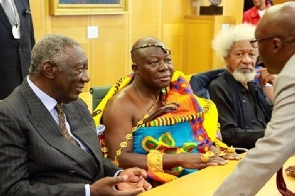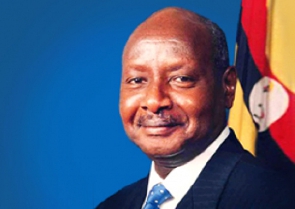- Home - News
- TWI News | TV
- Polls
- Year In Review
- News Archive
- Crime & Punishment
- Politics
- Regional
- Editorial
- Health
- Ghanaians Abroad
- Tabloid
- Africa
- Religion
- Election 2020
- Coronavirus
- News Videos | TV
- Photo Archives
- News Headlines
- Press Release
Opinions of Wednesday, 16 September 2009
Columnist: GNA
Fibre Optics: Africa on Information Superhighway
A GNA Feature by Samuel Dowuona
So much has been said about fibre optics over the last two years, particularly submarine fibre optics communications technology coming to Ghana.
The hype of the fibre optics talk was particularly fuelled by the sale of 70 per cent of the Enlarged Ghana Telecom to Vodafone at a "paltry" $900 million.
The Enlarged GT included the fixed line operations, the mobile phone operations (Onetouch), the call centre (Exzeed), the National Fibre Optics Backbone and the SAT-3 Submarine Fibre Optics landing station.
In simple terms, fibre optics refers to the technology that enables the transmission of information (as light impulses) along a glass-like or plastic-like wire other than the conventional copper wire. Fibre optic wire carries much more information at a faster speed than conventional copper wire and is far less subject to breaks in communications. It is widely used by telephone companies, around the world, for long-distance lines.
Because fibre optics transmits larger volumes of information (data and voice) at a higher speed, it makes internet and telecommunications more affordable than satellite does.
In fact, the coming of fibre optics has compelled satellite technology companies to slash down their prices by more than 50 per cent, said Karl Keppke, Regional Sales Director for O3b Networks, a satellite company with operations in Africa.
Mr Keppke told this writer, at the just ended Telecom World Africa Conference in Cape Town, South Africa, that he was confident that there would continue to be a fair mix of satellite and fibre optics communication technologies on the African Continent. The benefits fibre optics promises for Africa are obvious; speed and affordability of electronic communication; this means internet access and data transmission will be cheaper and voice communication could be free.
These are necessary to enable Africa to catch up with the rest of the world at a faster rate.
Another fall out advantage of fibre optics, particularly for those who are concerned about the spread of telecom masts in residential areas across Ghana, is that fibre optics does not need masts and antennae to operate. Satellite technology uses masts but fibre optics is underground technology.
Currently, Africa is virtually inundated in the sea of submarine fibre optic cables; there are at least eight undersea fibre optic cables, with an aggregate of 10.94 terabytes capacity, landing in almost all the coastal countries of Africa; some of the cables also provide connectivity to several inland countries.
The undersea cables available to Africa right now are SAT-3, 120 gigabytes; Main-one, 1.92 terabytes; Glo-one, 640 gigabytes; East African Submarine Cable System (EASSY), 1.3 terabytes; South Asia Telecom Cable (SEACOM), 1.2 terabytes; The Eastern African Marine Systems (TEAMS), 640 gigabytes; and the largest of them all, West Africa Cable System (WACS), 5.12 terabytes.
On the West Coast of Africa, SAT-3 (14,000km), WACS (14,000km) and Main one (14,000 km) connects Europe to South Africa, stretching from Portugal, with several landing stations along the western coast of Africa, including Ghana, down to the south.
Glo1 (9,500km), owned by Nigerian-based Globacom, connects United Kingdom to Nigeria, landing in Spain, Portugal, Morocco, Mauritania, Senegal and Ghana.
Ghana is a beneficiary of at least four submarine cables; SAT-3, which is currently 50 per cent live; Glo1, expected to go live later this year; Main-one due in May 2010 and WACS due 2011. All things being equal, in less than five years, the whole of Africa should be hooked unto fibre optics technology.
According to Mr Alhassan Umar, Executive Director of Information Technology Enable Service (ITES) Secretariat, with such a huge fibre optic capacity, Ghana stands to benefit in the area of business processes outsourcing (BPO).
He explained that the submarine fibre optics landing stations would provide a huge backup of redundant fibre optics capacity that would trigger investor confidence in the ability of the country's BPO companies to provide reliable, high speed and affordable communications service to their clients around the world.
On the eastern coast of Africa there is EASSY Way, 10,000km long, which connects South Africa to Sudan, with several landing stations along the eastern coast. Twenty other countries in south-eastern and north-eastern Africa are also connected to EASSY. SEACOM (15,000km) is also on the east, connecting France to India, with at least seven landing stations in Africa; from South Africa through the eastern coast to Egypt in the north.
TEAMS is 4,500km long and links Kenya with the United Arab Emirates, with possible landing stations in Rwanda, Southern Sudan, Ethiopia, Uganda, Tanzania and Burundi.
Affordable and high speed transmission of information, reduction in spread of telecom masts and confidence booster in Africa as a BPO hub, are all very good benefits of fibre optics for Africa, but telecom industry investors, operators and regulators think there is more to this fibre optics discussion than the expected benefits.
At the just ended Telecom World Africa 2009 conference in Cape Town South Africa, industry stakeholders expressed concern over whether the expected level of demand for fibre optics technology in Africa, is worth the billions of dollars being invested to develop the technology. The supply side has been well catered for, but there is a dilemma as to whether the level of demand would sustain the supply; the danger of a huge chunk of Africa's fibre optic capacity remaining redundant is staring industry stakeholders in the face.
TEAMS, for instance, is being constructed at a cost of $82 million; EASSY Way, $235; Main One, $240 million, SEACOM, $600 million and WACS, SAT-3 and GLO1 are all multi-million-dollar projects. One of the arguments was that, not many of the 72 GSM carriers and 35 CDMA operators (like Kasapa) in Africa can afford to buy fibre optics capacity.
Price per megabyte per month of fibre optic capacity differs from one cable to the other; on SAT-3, for instance, a megabyte of capacity costs between $4,500 to $12,000 per month; 50 times higher than what similar fibre optics capacity in the United States of America. WIOCC, majority shareholders of EASSY Way, said their capacity would sell for about a million dollars less than what is already on the market.
Currently, there are at least 80 drivers, including major telecom operators, internet service providers (ISPs) and corporate investors onboard the fibre optics train and actually driving the development of the technology.
That excludes a huge number of smaller telecom operators and their customers from the fibre optics revolution. Industry stakeholders also argued that fibre optics consumption lies more in data communication and internet connectivity than in voice, saying that the high level of illiteracy, poverty, power supply bottlenecks and lack of access to ICT infrastructure to a larger portion of Africa's population were genuine concerns for operators and investors.
It is, for instance, projected that data costs, which now averaged between $5,000 and $7,000 per megabit of bandwidth on satellite, would be reduced drastically to $500 per megabit on fibre optics, and that would translate into even more affordable transmission of data for the average African. (Source: TEAMS Kenya)
But people are not likely to do data communications if they are not educated and or cannot afford to acquire ICT equipment and hi-tech mobile handsets needed for that kind of communication. Again there is a huge power supply problem across Africa, which even makes it difficult for people who are able and can afford ICT equipment to do data communication effectively.
The call is, therefore, for telecom operators in Africa to collaborate with their respective governments of the countries they operate in to deal with some of the bottlenecks now, when not much of the fibre optics is live on the Continent yet.
In Ghana, the Government has awarded a $150 million contract to Huawei, a Chinese telecom infrastructure installation company, to provide infrastructure that would allow nationwide broadband connectivity on the back of the... long National Fibre Optics Backbone. Some of the operators, particularly MTN, have earmarked funds to build ICT centres in all 10 regions of the country to give internet access to schools and communities in the hinterlands. The Ghana Investment Fund for Electronic Communications (GIFEC) is also undertaking a similar project; providing ICT centres and power sources to un-served and under-served communities across the country. GIFEC and individual operators have also collaborated to provide lots of fixed wireless pay phones in rural communities and in schools to enable people make and receive calls as well as receive money transferred to them on pay phones.
Speaking of money transfer, the telecom operators in Ghana are also coming up with lots of Value Added Service (VAS), which makes convergence technology such as voice over internet protocol (VOIP), mobile money, mobile TV and others relevant to the average Africa. Indeed, convergence technology has been identified as one way by which much more fibre optics capacity could be consumed through the use of mobile handsets. There was one more concern about submarine fibre optic cables in Africa; security. The Chief Executive Officer of the Nigerian Regulator, Ernest Ndukwe said African states must put measures in place to ward off saboteurs and thieves from submarine fibre optic path and from the landing stations as well. Paul Edwards, Chairman of Starcomms Communications, Nigeria, who presided at the TWA 09 conference, said submarine fibre optics is bringing the kind of information technology available to the average citizen in a developed country to the average citizen of an African country with Mr Sarat Dutt Lallah, CEO of Mauritius Telecom adding that when the time comes, Africans would be ready for it. 15 Sept. 09










